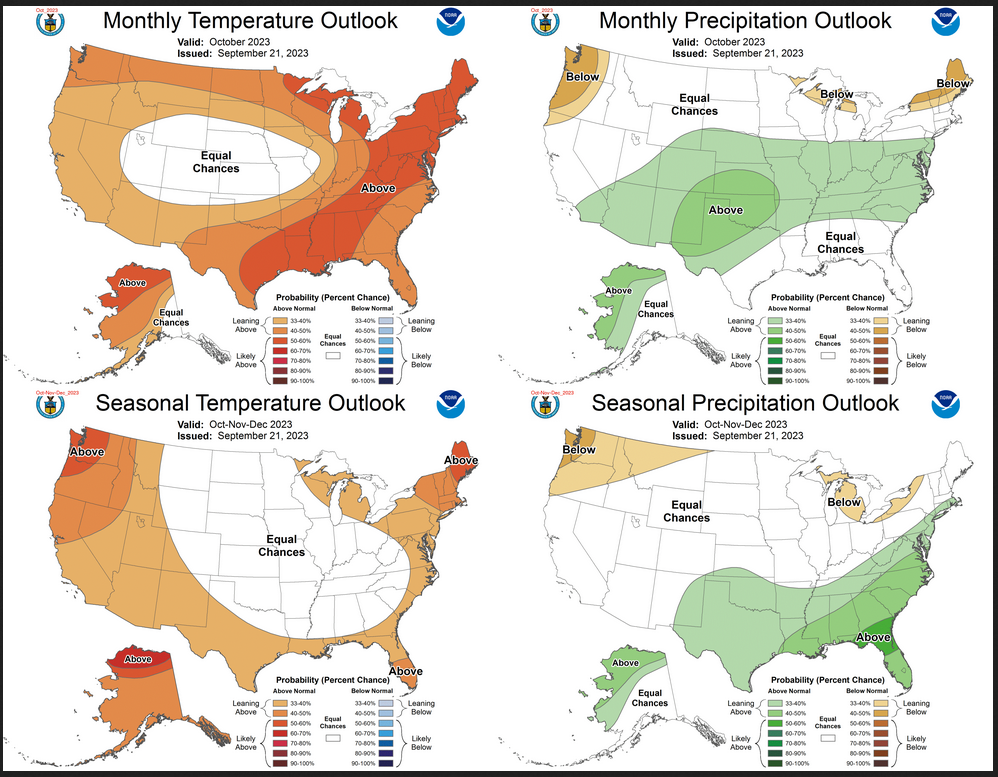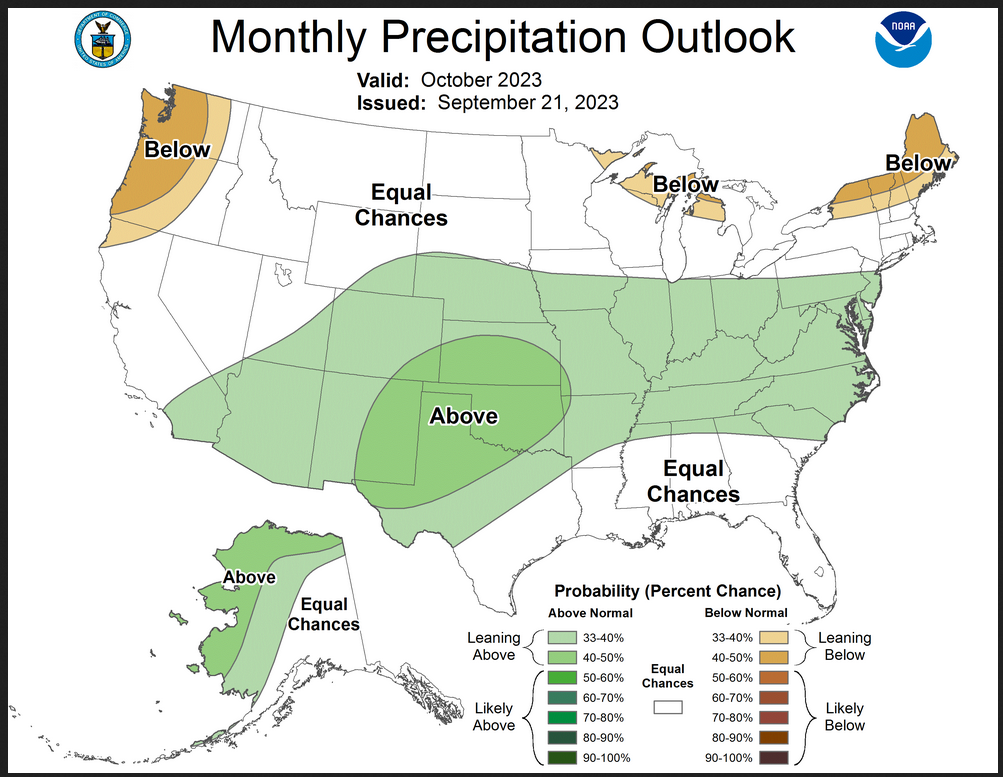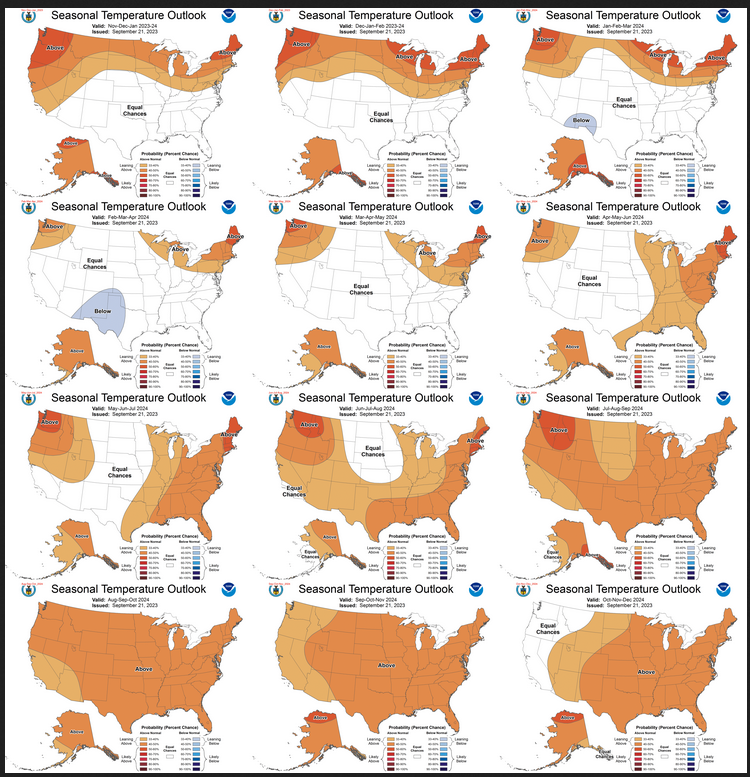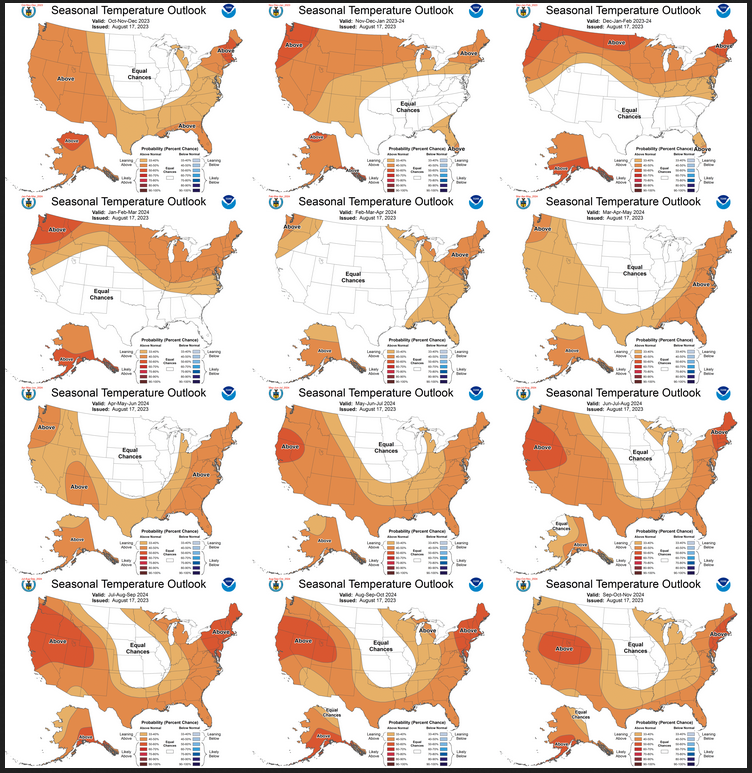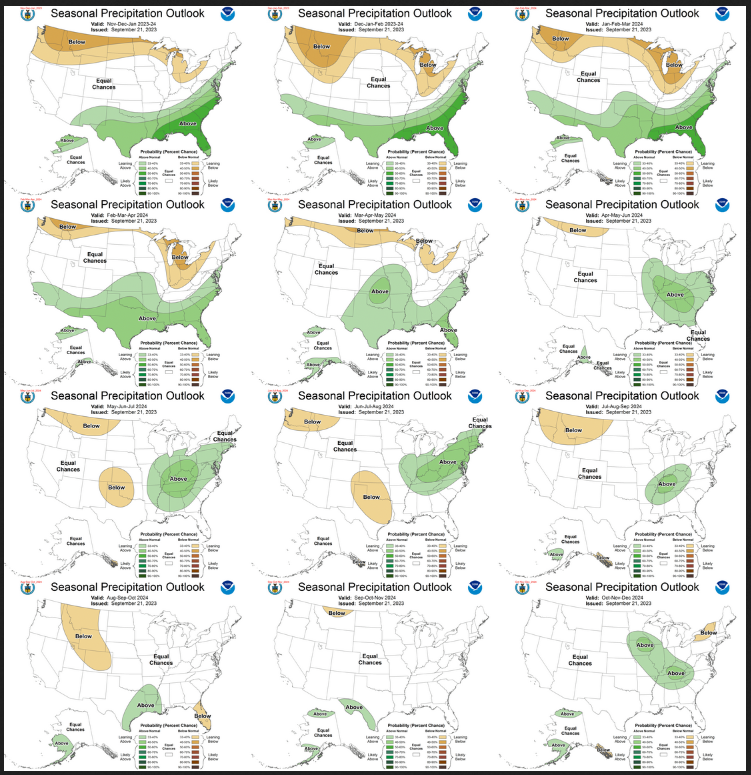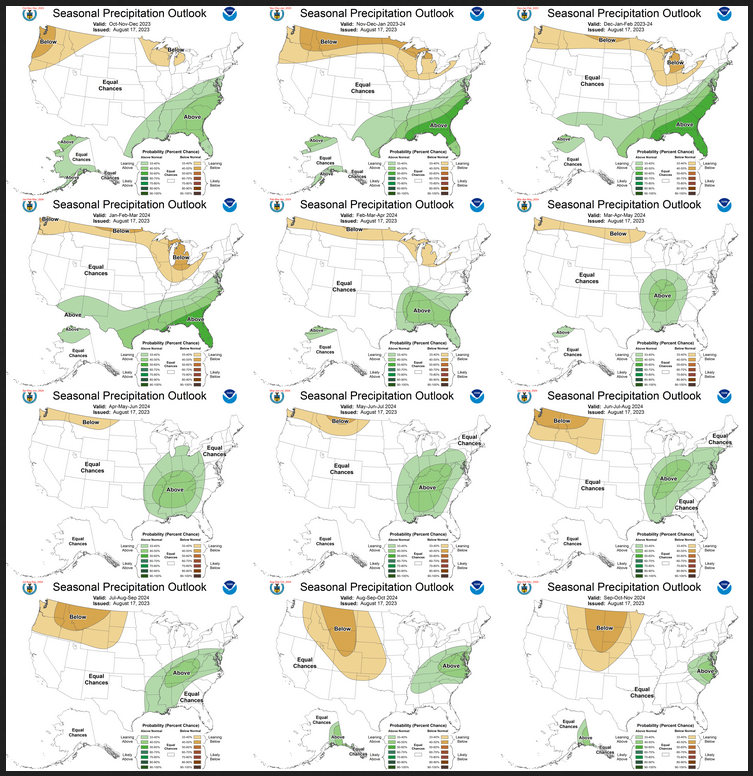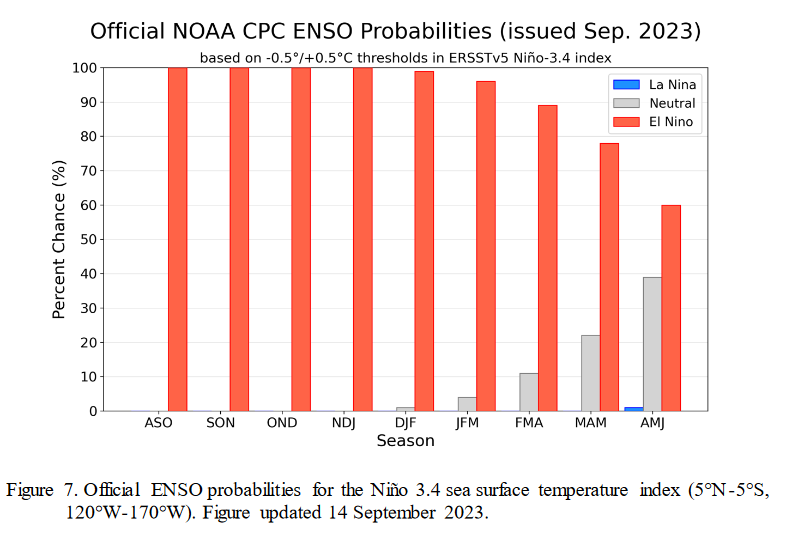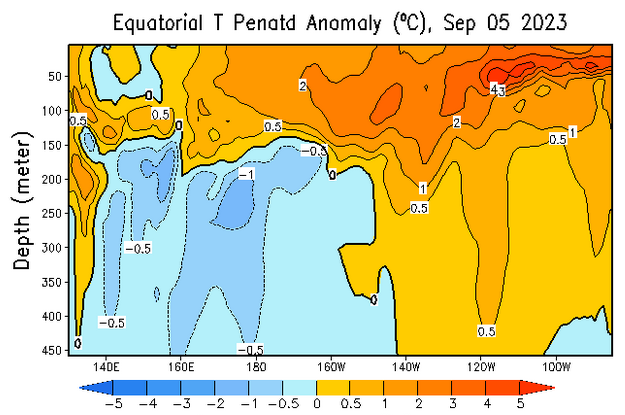On the third Thursday of the month right on schedule NOAA issued their updated Seasonal Outlook which I describe as their Four-Season Outlook because it extends a bit more than one year into the future. The information released also included the Mid-Month Outlook for the following month plus the weather and drought outlook for the next three months. I present the information issued by NOAA and try to add context to it. It is quite a challenge for NOAA to address the subsequent month, the subsequent three-month period as well as the twelve successive three-month periods for a year or a bit more. A seasonal drought outlook is also issued.
First, Let’s Take a Look at the (mid-month) Outlook for October. It will be updated on the last day of September.
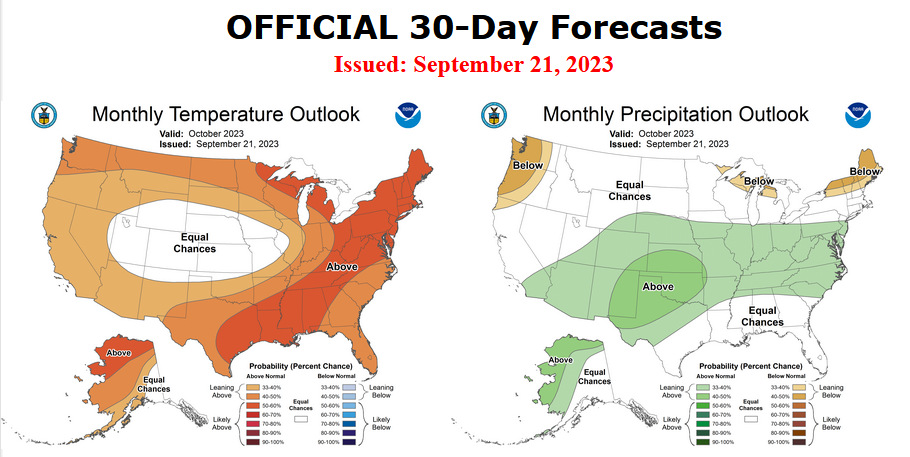
Then I present a graphic that shows both the preliminary Outlook for October and the three-month outlook for OND 2023. So you get the full picture in one graphic. For some, that may be all they are interested in. Others will be interested in the longer-term predictions and also the rationale supporting the predictions which is mostly provided by the NOAA discussion.
The top row is what is now called the Mid-Month Outlook for next month which will be updated at the end of this month. There is a temperature map and a precipitation map. The second row is a three-month outlook that includes next month. I think the outlook maps are self-explanatory. What is important to remember is that they show deviations from the current definition of normal which is the period 1991 through 2020. So this is not a forecast of the absolute value of temperature or precipitation but the change from what is defined as normal or to use the technical term “climatology”.
| Notice that the outlook for next month and the three-month outlooks are somewhat different with respect to temperature. This tells us that November and December will be different than October to some extent. |
The full NOAA Seasonal Outlook extends through October/November/December of 2024. All of these maps are in the body of the article. Large maps are there for October and the three-month period Oct/Nov/Dec. Small maps are provided beyond that through December of next year with a link to get larger versions of these maps.
NOAA provides an excellent discussion to support the maps and the changes which starting in the Spring of 2024 are significantly different from what was issued a month ago. [Author’s Note: many other meteorological agencies see this El Nino lasting longer than NOAA does so there is more than usual uncertainty relating to the more distant months. It seems to me that NOAA was showing some of these as El Nino months last month but has changed them to ENSO Neutral months in what they issued on September 21, 2023.]
Here are larger versions of the Temperature and Precipitation Outlook maps for next month.
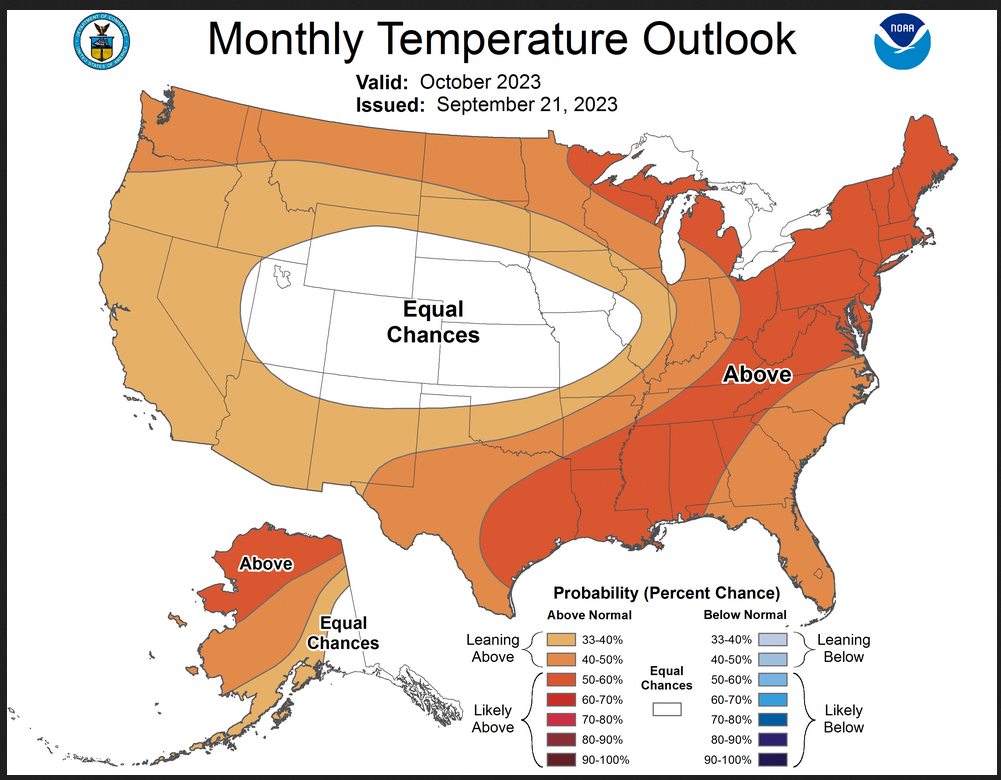
The maps are pretty clear in terms of the outlook.
And here are large versions of the three-month OND 2023 Outlook
First temperature followed by precipitation.
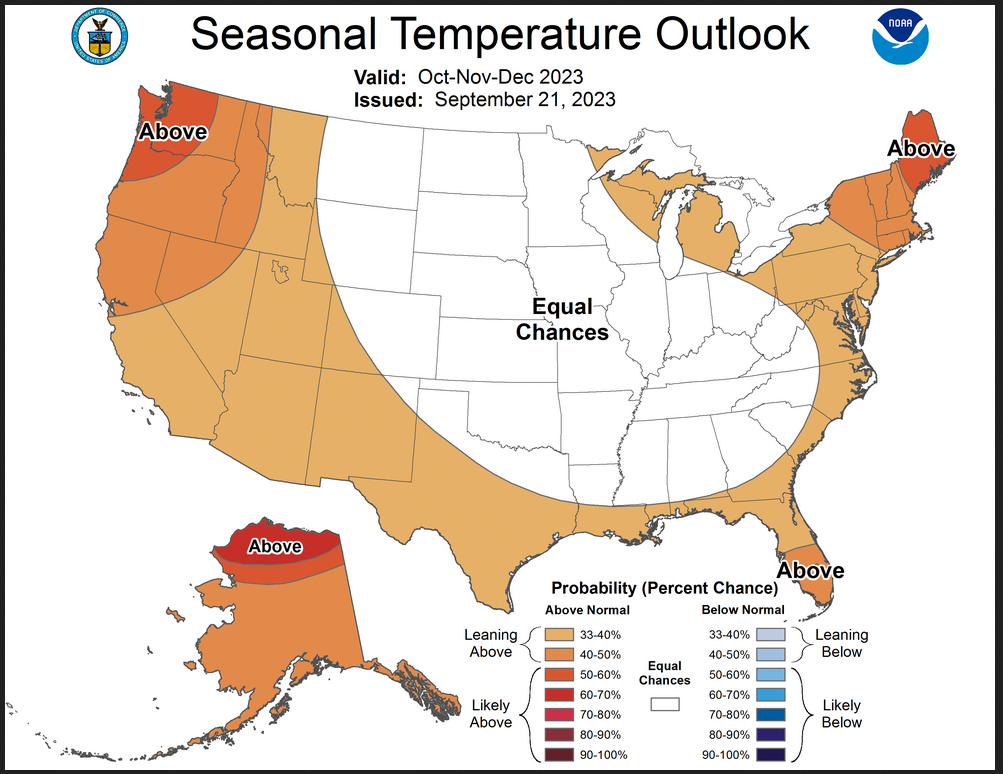

| These maps are larger versions of what was shown earlier. |
Drought Outlook
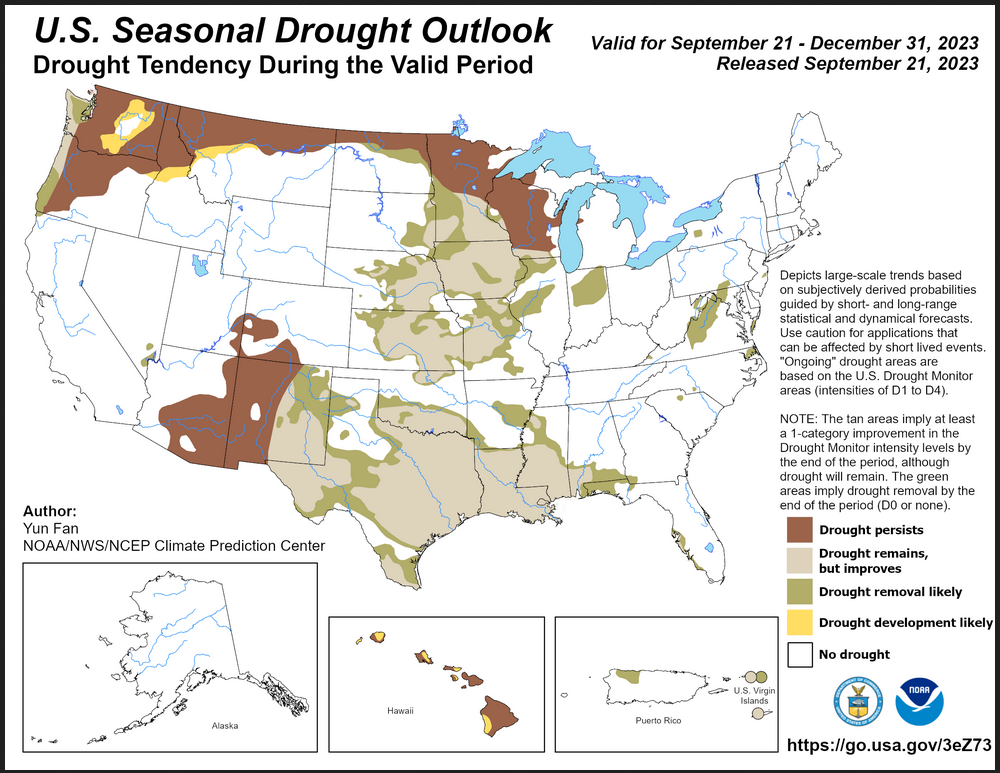
| The yellow is the bad news. There is a larger area where drought removal or lessening is likely to happen plus there is a large area where drought is expected to persist. |
Short CPC Drought Discussion
Latest Seasonal Assessment – During the past four weeks, widespread drought expansion (1-4 class degradation) occurred across much of the Southern Region and New Mexico, parts of central-eastern Arizona, the Pacific Northwest, Northern Rockies, Northern and Central Plains, Midwest, and northern Virginia due to episodes of extreme heat and dryness. Drought removal/improvement was observed over parts of southeastern California and adjacent Nevada and Utah due to heavy rainfall brought by Hurricane Hilary and its remnants. Periods of heavy rainfall also reversed the trend of drought development across much of Michigan and parts of western New York and adjacent Pennsylvania. Drought improvement/removal was also observed over parts of southern Texas, the Carolinas and Florida due to tropical storms. The autumn and early winter months are a highly transitional time of year, as the wet season begins to ramp up along the West Coast. Above-normal precipitation during the remainder of September and an increasingly wet climatology through the late fall and early winter favors improvement along coastal Oregon and Washington. Farther inland, increased chances of below-normal precipitation (October-November-December) favors persistence or development across the interior Pacific Northwest over existing drought regions across eastern parts of the Pacific Northwest and Northern Rockies. Drought conditions are also favored to persist over the existing drought regions across parts of the Four Corners region due to the suppressed Monsoon, weak predicted wet signals, and a drier climatology. Drought persistence is also favored for the northern Plains and Upper Mississippi Valley due to lack of a wet signal for the coming season, the areas entering its climatological dry season and a favorable time of year for soil moisture discharge. Drought improvement/removal is likely across eastern New Mexico, most of the Central and Southern Plains, parts of the Southeast and Northeast due to forecast above-normal precipitation and/or a favorable time of year for soil moisture recharge.Alaska currently is drought free and is likely to continue as the region enters the cold season of the year. Removal or improvement are anticipated for drought across Puerto Rico and the U.S. Virgin Islands. Drought persistence and development is forecast for the Hawaiian Islands due to forecast below-normal precipitation.
Looking out Four Seasons.
Twelve Temperature Maps. These are overlapping three-month maps (larger versions of these and other maps can be accessed HERE)
Notice that this presentation starts with November/December/January 2023/2024 (NDJ) since OND is considered the near-term and is covered earlier in the presentation. The changes over time are generally discussed in the discussion but you can see the changes easier in the maps.
Comparing the new outlook with the prior Outlook,
The 12 temperature maps issued last month.
The easiest way to do the comparison is to print out both maps. If you have a color printer that is great but not needed. What I do is number the images from last month 1 – 12 starting with “1” and going left to right and then dropping down one row. Then for the new set of images, I number them 2 – 13. That is because one image from last month in the upper left is now discarded and a new image on the lower right is added. Once you get used to it, it is not difficult. In theory, the changes are discussed in the NOAA discussion but I usually find more changes. It is not necessarily important. I try to identify the changes but believe it would make this article overly long to enumerate them. The information is here for anyone who wishes to examine the changes. I comment below on some of the changes from the prior report by NOAA and important changes over time in the pattern.
| Basically, there are no significant changes from last month’s set of maps until MAM of 2024 and at that point, the new maps are quite different from the maps issued last month. |
Now the Twelve New Precipitation Maps
Similar to Temperature in terms of the organization of the twelve overlapping three-month outlooks.
Comparing the new outlook with the prior Outlook,
The maps that were released last month.
A good approach for doing this comparison is provided with the temperature discussion.
| There were basically no significant changes from last month’s set of maps until FMA of 2024 at which point they are quite different. |
NOAA Discussion
Maps tell a story but to really understand what is going you need to read the discussion. I combine the 30-day discussion with the long-term discussion and rearrange it a bit and add a few additional titles (where they are not all caps the titles are my additions). Readers may also wish to take a look at the article we published last week on the NOAA ENSO forecast. That can be accessed here.
I will use bold type to highlight some things that are especially important. My comments, if any, are enclosed in brackets [ ].
CURRENT ATMOSPHERIC AND OCEANIC CONDITIONS
The coupled oceanic and atmospheric observations reflect El Niño conditions. In August, sea surface temperatures (SSTs) were above average across the equatorial Pacific Ocean with strengthening positive anomalies noted in the central and east-central Pacific. In the last week, the Niño index values ranged from +1.1°C to +2.6°C. Area-averaged subsurface temperature anomalies increased compared to July in association with anomalous warmth in the central and eastern equatorial Pacific Ocean. Tropical atmospheric anomalies were also consistent with El Niño. Over the east-central Pacific, low-level winds were anomalously westerly, while upper-level winds were anomalously easterly. Convection was slightly enhanced around the International Date Line, stretching into the eastern Pacific, just north of the equator. Convection was mostly suppressed around Indonesia. The equatorial Southern Oscillation Index (SOI) and the traditional station-based SOI were both significantly negative. Collectively, the coupled ocean-atmosphere system reflected El Niño.
The Real-time Multivariate Madden Julian Oscillation (RMM) index currently indicates incoherent intraseasonal activity, with the Madden Julian Oscillation (MJO) signal retreating westward to the Indian Ocean at a low amplitude during the past week. Dynamical model RMM forecasts generally favor the resumption of an eastward propagating MJO signal over the Maritime Continent, but remain divided in regards to its eventual amplitude with large ensemble spread.
PROGNOSTIC DISCUSSION OF SST FORECASTS
The most recent International Research Institute for Climate and Society (IRI) plume indicates El Niño will persist through the Northern Hemisphere winter 2023-24. Despite nearly the same ensemble mean amplitude as last month, the shorter forecast horizon means that the odds of a “strong” El Niño (≥1.5°C for the November-January seasonal average in Niño-3.4) have increased to 71%. In summary, El Niño is anticipated to continue through the Northern Hemisphere winter (with a greater than 95% chance through JFM 2024).
PROGNOSTIC TOOLS USED FOR U.S. TEMPERATURE AND PRECIPITATION OUTLOOKS
Dynamical model forecasts from the North American Multi-Model Ensemble (NMME), the Coupled Forecast System model Version 2 (CFSv2), and the Copernicus (C3S) multi-model ensemble system were used extensively for the first six leads when they are available, as was the objective, historical skill-weighted consolidation and Calibration, Bridging, and Merging (CBaM) guidance, that combines both dynamical and statistical forecast information.
Additionally, the official ENSO forecast depicts probabilities of El Niño that are exceptionally high through the upcoming winter, with a strong event likely. This anticipated El Niño signal played a key role in the construction of these outlooks. At later leads, decadal trends in temperature and precipitation were increasingly relied upon in creating the seasonal outlooks.
30-DAY OUTLOOK DISCUSSION FOR OCTOBER 2023
El Nino conditions remain strongly in place across the equatorial Pacific Ocean both in the ocean as well as the atmosphere and so is considered in the preparation of the October outlook. Potential impacts, however, are less likely and generally weaker than that sometimes observed during winter and early spring. Recent MJO activity has not been strong in recent weeks as compared to earlier in 2023. Some model forecasts of the RMM index and other MJO forecast tools indicate potential strengthening in the western Pacific (WPAC), but there is considerable uncertainty overall in this outcome especially given ongoing robust El Nino conditions.
Eventual evolution of the MJO amplitude and phase notwithstanding, conditions in the WPAC remain quite conducive for tropical cyclone development over the next few weeks in the WPAC as forecast in the latest CPC Global Tropics Hazards Outlook (GTH). Since late September and October is near the peak for extratropical circulation influencing WPAC re-curving typhoons, predictability and overall forecast confidence is generally at a minimum for October within the seasonal cycle. The October outlook will be updated on the last day of September utilizing the latest information including that related to the above uncertainties.
Temperature
The October 2023 temperature outlook favors above-normal monthly mean temperatures for the majority of the forecast domain with the only exceptions being Southeast Alaska and the Alaska Panhandle as well as a region from the central Rockies to the central Plains where Equal-Chances (EC) of either of the three categories are equally likely. The greatest probabilities for above-normal temperatures are forecast for areas in northern and western Alaska and for the Great Lakes, Northeast, mid-Atlantic and parts of the Southeast and Gulf coast.
For Alaska, reduced sea ice coverage and above-normal sea surface temperatures (SSTs) in surrounding waters elevate odds for warmer than normal conditions as well as El Nino considerations and dynamical model guidance from the NMME and C3S contributing ensemble systems. Chances for above-normal temperatures decrease moving south and east across Alaska.
Through a considerable period of the first half of the month of October, model forecasts from extended-range and subseasonal systems (ECMWF, GEFSv12, JMA, CFS and others) indicate the likelihood of substantial positive 500-hPa height anomalies associated with both ridging as well as a general northward shift in the mean westerlies over central North America including the northern CONUS. As a result, above-normal temperatures are most likely for the northern tier of the U.S., the eastern CONUS and southern Plains. Considerably above-normal SSTs in the Gulf of Mexico and along the Atlantic seaboard also support favored above-normal temperatures in these areas. Short-term climate prediction models as part of the NMME and C3S ensemble systems indicate this forecast outcome is maintained in the monthly mean temperature forecast.
Elevated probabilities for above-normal temperatures for much of the western CONUS are low due to uncertainty in model guidance and other forecast tools at the start of October. Conflicting forecast tools and El Nino considerations (i.e., potential below-normal temperatures) led to a forecast of EC for a region in the interior CONUS.
Precipitation
For precipitation, elevated odds of above-normal October monthly total precipitation amounts are forecast from the Southwest eastward to include parts of the central Rockies, central and southern Plains, Ohio Valley and mid-Atlantic. The forecast for the center of this region is mainly supported by the likelihood of more unsettled conditions underneath forecast ridging to the north as noted above and this is consistent with much of the extended-range and short-term climate prediction model guidance. Although only slightly elevated, above-normal precipitation is forecast for some areas in the Southwest due to potential tropical influences of overall enhanced moisture, tropical cyclone impacts and El Nino considerations. Potential unsettled conditions underneath ridging, partial model guidance support and positive precipitation long term trends slightly favor above-normal precipitation for the Ohio Valley and mid-Atlantic.
Above-normal precipitation is also favored for western and northern Alaska supported by more open and warmer waters both over a larger area in the northeast Pacific as well as more nearby waters of the Bering Sea, Chukchi Sea and Beaufort Sea.
Northward shifted westerlies and ridging as indicated by extended-range and subseasonal model guidance in early October and short-term climate prediction models (NMME and C3S) elevate odds for below-normal precipitation for parts of the Pacific Northwest and an area from the northern Great lakes to New England. El Nino considerations (i.e., potential below-normal precipitation) also supports the forecast for the area highlighted in the Pacific Northwest.
SUMMARY OF THE OUTLOOK FOR NON-TECHNICAL USERS (with a focus on October through December)
El Niño conditions are present, as represented in current oceanic and atmospheric observations. A continuation of El Niño is extremely likely this Fall and Winter, with over a 95 percent chance through January-February-March (JFM) 2024. Additionally, a strong El Niño is likely by late Fall and early Winter, with approximately a 70 percent chance of occurrence during the November-December-January (NDJ) 2023-24 season.
The October-November-December (OND) 2023 temperature outlook favors above normal temperatures for Alaska, the western third of the Contiguous United States (CONUS), the Northeast, Great Lakes, parts of the Southern Plains, Florida, and the immediate Gulf and East Coasts. The largest probabilities (greater than 60 percent) of above normal temperatures are forecast across the North Slope of Alaska. Above normal temperatures are also likely (probabilities greater than 50 percent) for parts of the Pacific Northwest and northern New England. The OND 2023 precipitation outlook depicts enhanced probabilities of above normal precipitation amounts across the Southeast, Southern Plains, and parts of the mid-Atlantic states as well as northern and western Alaska. The greatest chances of above normal precipitation (above 50 percent probability) are indicated for parts of northern Florida and southern Georgia. Equal chances (EC) are forecast for areas where probabilities for each category of seasonal mean temperatures and seasonal accumulated precipitation amounts are expected to be similar to climatological probabilities.
BASIS AND SUMMARY OF THE CURRENT LONG-LEAD OUTLOOKS
PROGNOSTIC DISCUSSION OF OUTLOOKS – OND 2023 TO OND 2024
TEMPERATURE
One of the major forecast challenges for the upcoming fall and winter is managing the competing influences between El Niño and recent trends . Across the southern CONUS in particular, El Niño composites tend to favor cooler than normal conditions while recent trends lean warm. Due to these competing influences, a large swath of EC is indicated across much of the interior South for OND. A slight tilt toward above normal temperatures is indicated along the Gulf and East coasts, where warm trends and above normal SSTs have a greater chance to counteract potential El Niño influences. Above normal temperatures are favored with greater confidence across the Northeast and parts of the Great Lakes, where recent trends and model guidance from the C3S are warm. Probabilities of above normal temperatures exceed 50 percent across parts of northern New England where recent trends are the strongest and SSTs in the adjacent Atlantic Ocean are warmer than normal. Recent trends and dynamical models guidance also favor warmth across the western third of the CONUS. The greatest probabilities of above normal temperatures (above 50 percent chance) are indicated for the Pacific Northwest, where dynamical and statistical inputs are in generally good agreement and adjacent SSTs are above normal. Relatively weaker probabilities of above normal temperatures (less than 40 percent chance) are indicated over the southwestern CONUS, where El Niño influences may counteract recent warm trends . Farther to the north and east, EC is indicated for the north-central CONUS where guidance from the NMME and recent trends yield weak signals . Above normal temperatures are favored throughout Alaska as El Niño, trend, and dynamical model guidance all favor milder than normal conditions across much of the state. The strongest probabilities of above normal temperatures (greater than 60 percent chance) are indicated across the North Slope as sea ice extent is currently much below normal across the adjacent Arctic Ocean.
From November-December-January (NDJ) through March-April-May (MAM), impacts from the ongoing El Niño strengthen as above normal temperatures are favored across the northern CONUS and persist across Alaska. EC is indicated across the southern CONUS as El Niño favors cooler than normal conditions for most of the region while recent trends favor warm. A small area of enhanced below normal temperature probabilities are indicated for parts of the Southwest and southern High Plains during JFM and FMA where El Niño composites yield a cold signal and recent trends are relatively weak. After MAM, the forecast pattern increasingly reflects trends with above normal temperatures generally favored across the Northeast during Spring and then expanding across the entire eastern third of the CONUS by the early Summer. Similarly, an area of elevated above normal temperature probabilities across the Northwest during the Spring expands across most of the remainder of the western third of the CONUS during the summer months. Alaska is generally favored to experience milder than normal conditions throughout the spring and summer months. During the late summer and early fall, trends favor warmth across all of the forecast domain so above normal temperature probabilities are elevated cross the entire nation from JAS through SON. Trends weaken later in the Fall across southeastern Alaska and the northwestern CONUS where EC is indicated during the OND 2024 season.
PRECIPITATION
Model guidance and El Niño composites are in good agreement in favoring above normal precipitation across the southeastern CONUS and along much of the East Coast during the OND 2023 season. Thus, above normal precipitation is favored for these regions. Probabilities of above normal precipitation exceed 50 percent across parts of northern Florida and southern Georgia, where ensemble guidance from the NMME and C3S yield the strongest wet signals . Elevated probabilities of above normal precipitation also expand west to the Southern Plains, consistent with combined El Niño/Optimal Climate Normals (OCN) composites. Conversely, below normal precipitation is more likely across the northwestern CONUS and the Great Lakes region, based primarily on a combination of El Niño composites and dynamical model guidance. Above normal precipitation is favored across northern and western Alaska due to anticipated El Niño influences, recent trends , and dynamical model guidance. Below normal sea ice extent in the adjacent Arctic Ocean may also contribute to increased precipitation chances across the North Slope.
During the winter months, impacts from El Nino are expected to increase, and above normal precipitation is favored for most of the Southern Tier of the CONUS from NDJ to February-March-April (FMA). Additionally, above normal precipitation is favored along much of the Eastern Seaboard during the core of the winter as an East Coast storm track is generally favored during El Niño winters. Conversely, below normal precipitation is more likely across much of the Northern Tier, particularly for the northwestern CONUS and the Great Lakes region. Uncertainty is high across the West Coast as El Niño tends to favor wet along much of the California coast while trends favor dry. Given the increased possibility of a strong El Niño event, a tilt toward above normal precipitation is indicated for Southern California. A tilt toward above normal precipitation is also indicated across the North Slope of Alaska through FMA, consistent with recent trends . Confidence in potential ENSO impacts decreases substantially as we head to next Spring and Summer, resulting in increased uncertainty and coverage of EC across much of the nation. However, during late Winter and early Spring (FMA), guidance from the CFSv2 and other models yields a wet signal across the Southern and Central Plains. The wet signal generally progresses eastward across the Southeast by early Summer (April-May-June (AMJ)) and then to the Mid-Atlantic and Northeast by the middle of the summer (June-July-August (JJA)), consistent with trends . As this wet signal progresses eastward and northward, the statistical consolidation and trends become increasingly dry over parts of the Central and Southern Plains by late Spring and early Summer. As a result, below normal precipitation is slightly favored across these regions during May-June-July (MJJ) and JJA. A slight tilt toward below normal precipitation is also indicated for parts of the northern High Plains and Northern Rockies through August-September-October (ASO), consistent with trends. Farther to the north, uncertainty is high for most of Alaska, and EC is indicated for most of the state from late Spring through the Summer. As we enter the late summer and early fall, a wet trend signal is reflected across parts of the Tennessee Valley during July-August-September (JAS), translating farther to the south and west across the western Gulf Coast in ASO and Rio Grande Valley deeper into next Fall in September-October-November (SON). Above normal precipitation is favored for the North Slope of Alaska next Fall due to recent trends and the statistical consolidation also favors above normal precipitation for southwestern parts of the state during the same time period Later next Fall and early next Winter (OND), recent trends depict a tilt toward dry for parts of Southeast Alaska and the eastern Great Lakes, and a wet signal for parts of the Upper and Middle Mississippi Valley and the Tennessee Valley.
Review of the ENSO Assumptions utilized by NOAA (CPC) in Preparing this Four-Season OutlookThe key information used by NOAA follows.
| It looks like El Nino through the forecast period. It does start to reduce intensity in DJF 2023/2024. I think the Seasonal Outlook this month starts to change from last month as there is increasing confidence that this El Nino will weaken in the Spring which is shown here as the probabilities of El Nino beginning to converge with the probabilities of ENSO Neutral. |
Tropical Subsurface Temperature Anomalies
| You can update this graphic by clicking HERE and scrolling down to “Mean and anomalous equatorial temperatures“. One has to differentiate between the surface and at depth. |
| The image will update if you click HERE. This model is predicting a fairly strong El Nino lasting a while. |
Resources
–
| I hope you found this article interesting and useful. |
–
